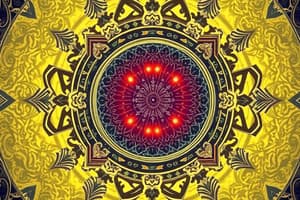Podcast
Questions and Answers
What happens during the positive half cycle of the input AC voltage in a centre tapped rectifier?
What happens during the positive half cycle of the input AC voltage in a centre tapped rectifier?
- The diode D2 is forward biased while D1 is reverse biased.
- Only the negative half cycle contributes to the load voltage.
- The current flows through the circuit and D1 charges the capacitor to peak value. (correct)
- The capacitor discharges through load resistance RL.
What is the effect of the capacitor in a centre tapped transformer full-wave rectifier circuit?
What is the effect of the capacitor in a centre tapped transformer full-wave rectifier circuit?
- It increases the AC voltage across the load.
- It acts to smooth the output by bypassing AC components. (correct)
- It discharges instantly across the load during both half cycles.
- It decreases the average DC value of the load current.
What happens to the voltage across the capacitor after it charges during the positive half cycle?
What happens to the voltage across the capacitor after it charges during the positive half cycle?
- The voltage remains constant regardless of load.
- It decreases exponentially with the time constant RL C. (correct)
- It increases linearly with time until the next cycle.
- It immediately drops to zero after the capacitor is charged.
During the negative half cycle of the input voltage, what state are the diodes in a centre tapped rectifier?
During the negative half cycle of the input voltage, what state are the diodes in a centre tapped rectifier?
What characterizes the load current in a rectifier circuit according to Fourier’s theorem?
What characterizes the load current in a rectifier circuit according to Fourier’s theorem?
What is the maximum current that a low current diode can typically handle?
What is the maximum current that a low current diode can typically handle?
How does the depletion region behave in a forward-biased pn-junction?
How does the depletion region behave in a forward-biased pn-junction?
What happens to the built-in potential of a pn-junction in reverse bias?
What happens to the built-in potential of a pn-junction in reverse bias?
What type of diode material is indicated by a dimensionless number η of 1?
What type of diode material is indicated by a dimensionless number η of 1?
In the equation I = Irs [e^(qV/(kB T)) - 1], what does Irs represent?
In the equation I = Irs [e^(qV/(kB T)) - 1], what does Irs represent?
What is the significance of the forward voltage threshold (Vf) in a pn-junction?
What is the significance of the forward voltage threshold (Vf) in a pn-junction?
Which of the following can survive the largest reverse voltages?
Which of the following can survive the largest reverse voltages?
What role do the holes on the p side play in a reverse-biased pn-junction?
What role do the holes on the p side play in a reverse-biased pn-junction?
What forms the depletion region in a pn-junction diode?
What forms the depletion region in a pn-junction diode?
What is the built-in potential Vbi for silicon (Si) in a pn junction diode?
What is the built-in potential Vbi for silicon (Si) in a pn junction diode?
Which type of current is caused by the concentration gradient in a pn junction diode?
Which type of current is caused by the concentration gradient in a pn junction diode?
Under steady state conditions, what is the relationship between drift current and diffusion current in a pn junction diode?
Under steady state conditions, what is the relationship between drift current and diffusion current in a pn junction diode?
What happens to a pn junction diode when it becomes reverse biased?
What happens to a pn junction diode when it becomes reverse biased?
What is the effect of a high level of forward current on a pn junction diode?
What is the effect of a high level of forward current on a pn junction diode?
Which formula correctly describes the width of the depletion region Wdep in an open circuit pn junction?
Which formula correctly describes the width of the depletion region Wdep in an open circuit pn junction?
What causes the electric field E in a pn junction diode?
What causes the electric field E in a pn junction diode?
What is the main function of the capacitor in a half wave rectifier circuit?
What is the main function of the capacitor in a half wave rectifier circuit?
During which part of the input voltage cycle does the diode become reverse biased in a half wave rectifier?
During which part of the input voltage cycle does the diode become reverse biased in a half wave rectifier?
What happens to the output waveform in a half wave rectifier with a capacitor filter?
What happens to the output waveform in a half wave rectifier with a capacitor filter?
In a full wave rectifier using a bridge circuit, which diodes are forward biased during the positive half cycle?
In a full wave rectifier using a bridge circuit, which diodes are forward biased during the positive half cycle?
What is a notable characteristic of the waveform produced by a full wave rectifier?
What is a notable characteristic of the waveform produced by a full wave rectifier?
In a center tapped transformer full wave rectifier circuit, which diode is forward biased during the positive half cycle?
In a center tapped transformer full wave rectifier circuit, which diode is forward biased during the positive half cycle?
How does the capacitor behave when the input voltage exceeds the capacitor voltage in a half wave rectifier?
How does the capacitor behave when the input voltage exceeds the capacitor voltage in a half wave rectifier?
What defines the ripple in the output voltage of a filtered half wave rectifier?
What defines the ripple in the output voltage of a filtered half wave rectifier?
What is the efficiency formula for a half wave rectifier?
What is the efficiency formula for a half wave rectifier?
What is the peak inverse voltage (PIV) for a centre tapped transformer?
What is the peak inverse voltage (PIV) for a centre tapped transformer?
What characteristic does a positive series clipper exhibit?
What characteristic does a positive series clipper exhibit?
Which configuration uses the equation $P_{IV} = V_{m}$?
Which configuration uses the equation $P_{IV} = V_{m}$?
Calculate the efficiency of a full wave rectifier using the formula $\eta = \frac{I_{dc}}{I_{rms}}$.
Calculate the efficiency of a full wave rectifier using the formula $\eta = \frac{I_{dc}}{I_{rms}}$.
What happens when light is focused on the junction of a photodiode?
What happens when light is focused on the junction of a photodiode?
In which scenario would a negative clamper be used?
In which scenario would a negative clamper be used?
What is the effect of a biased clipper on a signal?
What is the effect of a biased clipper on a signal?
Flashcards are hidden until you start studying
Study Notes
PN Junction Diode
- A pn junction diode is formed by joining a p-type and n-type semiconductor material.
- Holes and electrons recombine at the junction, leaving behind uncovered bound charges which create a depletion region.
- The depletion region is characterized by a potential barrier or built-in potential (Vbi), typically 0.7V for silicon and 0.3V for germanium.
- An electric field exists across the junction due to the uncovered charges and depletion region.
- Two types of current flow occur in pn junction diodes: diffusion current and drift current.
- Diffusion current arises from the concentration gradient of charge carriers. Holes diffuse from the p-type to n-type, and electrons diffuse from the n-type to p-type.
- Drift current is caused by the electric field across the junction. Holes drift from n-type to p-type, and electrons drift from p-type to n-type.
- Under steady state, drift current equals diffusion current, resulting in zero net current in an open circuit.
- The width of the depletion region (Wdep) in an open circuit pn junction is determined by the doping concentrations of the p and n regions.
- A pn junction diode acts as a switch: ON when forward biased, and OFF when reverse biased.
Diode Characteristics
- The total current (I) flowing through a pn junction diode is described by the diode equation.
- The equation includes the reverse saturation current (Irs), the electron charge (q), Boltzmann's constant (KB), temperature (T), and a dimensionless number (η).
- Forward biased pn junction:
- The depletion region width and built-in potential decrease.
- Majority charge carriers move from one side to the other, resulting in current flow.
- Significant forward current starts flowing when the applied voltage (Vf) exceeds the built-in potential (Vbi).
- Reverse biased pn junction:
- The depletion region width and built-in potential increase.
- The junction acts as a high impedance to dc components, but low resistance to ac components.
Diode Applications
- Rectifiers: Devices used to convert alternating current (AC) to direct current (DC).
- Half-wave rectification: Produces a single pulse of DC current per AC cycle.
- Full-wave rectification: Uses a bridge or center-tapped transformer configuration to produce DC current for both positive and negative half-cycles of the AC input.
- Filtering: Used to smooth out the ripple in the rectified DC output.
- Capacitor filter: A capacitor connected in parallel with the rectifier output stores charge during the input voltage peaks and discharges during the valleys, reducing ripple.
Rectifier Parameters
- Average DC value (Idc): The average current flowing through the load in a rectifier circuit.
- Rectification efficiency (η): The ratio of DC power (Pdc) to AC power (Pac) delivered to the load.
- Peak inverse voltage (PIV): The maximum reverse voltage that the diode can withstand without breaking down.
Diode Clipping and Clamping Circuits
- Clipping circuits: Limit the output voltage to a specific level.
- Can be positive or negative, series or parallel, and biased.
- Clamping circuits: Shift the DC level of a signal without affecting its shape.
- Can be positive or negative, and can be biased.
Photodiode
- A photodiode generates free electrons and holes by absorbing incident light.
Studying That Suits You
Use AI to generate personalized quizzes and flashcards to suit your learning preferences.



